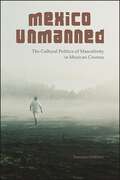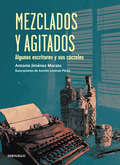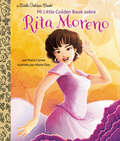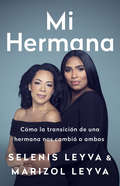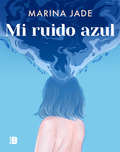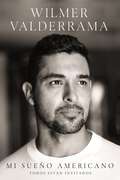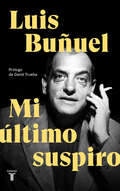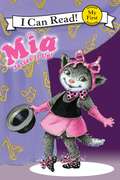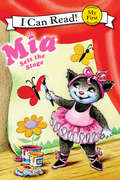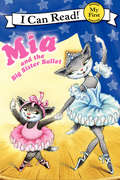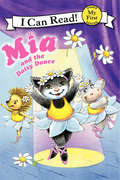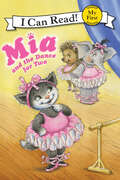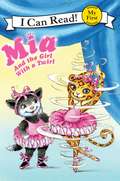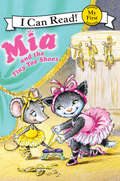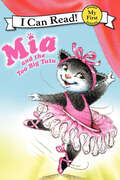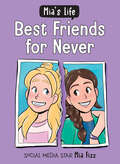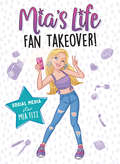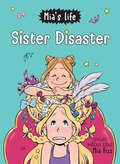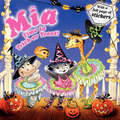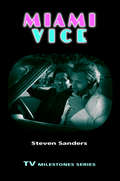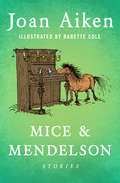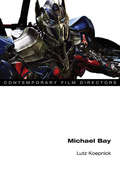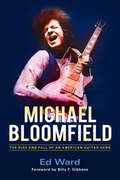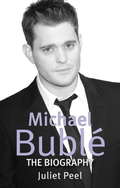- Table View
- List View
Mexico City in Contemporary Mexican Cinema
by David William FosterJust as Mexican national life has come to center on the sprawling, dynamic, almost indefinable metropolis of Mexico City, so recent Mexican cinema has focused on the city not merely as a setting for films but almost as a protagonist in its own right, whose conditions both create meaning for and receive meaning from the human lives lived in its midst. <P><P>Through close readings of fourteen recent critically acclaimed films, this book watches Mexican cinema in this process of producing cultural meaning through its creation, enaction, and interpretation of the idea of Mexico City. David William Foster analyzes how Mexican filmmakers have used Mexico City as a vehicle for exploring such issues as crime, living space, street life, youth culture, political and police corruption, safety hazards, gender roles, and ethnic and social identities. The book is divided into three sections. "Politics of the City" examines the films Rojo amanecer, Novia que te vea, Frida, naturaleza viva, and Sexo, pudor y lágrimas. "Human Geographies" looks at El Callejón de los Milagros, Mecánica nacional, El castillo de la pureza, Todo el poder, and Lolo. "Mapping Gender" discusses Danzón, De noche vienes, Esmeralda, La tarea, Lola, and Entre Pancho Villa y una mujer desnuda.
Mexico Unmanned: The Cultural Politics of Masculinity in Mexican Cinema (SUNY series in Latin American Cinema)
by Samanta OrdóñezIconic images of machismo in Mexico's classic cinema affirm the national film industry's historical alignment with the patriarchal ideology intrinsic to the post-revolutionary state's political culture. Filmmakers gradually turned away from the cultural nationalism of mexicanidad, but has the underlying gender paradigm been similarly abandoned? Films made in the past two decades clearly reflect transformations instituted by a neoliberal regime of cultural politics, yet significant elements of macho mythology continue to be rearticulated. Mexico Unmanned examines these structural continuities in recent commercial and auteur films directed by Alfonso Cuarón, Carlos Cuarón, Carlos Reygadas, Amat Escalante, and Julio Hernández Cordón, among others. Informed by cinema's role in Mexico's modern/colonial gender system, Samanta Ordóñez draws out recurrent patterns of signification that reproduce racialized categories of masculinity and bolster a larger network of social hierarchies. In so doing, Ordóñez dialogues with current intersectional gender theory, fresh scholarship on violence in the neoliberal state, and the latest research on Mexican cinema.
Mezclados y agitados
by Antonio Jiménez«Hudson estaba bebiendo otro daiquiri helado y al levantarlo, pesado y con la copa bordeada de escarcha, miró la parte clara debajo de la cima de frapé y le recordó el mar.»Ernest Hemingway, Islas a la derivaMás libros de los que podemos imaginar comenzaron en la barra de un bar, crecieron en la sobremesa e, incluso, cuajaron en la resaca. La relación de los libros con el alcohol va más allá de la afición de sus autores por los destilados: la mejor literatura ha surgido, siempre, de la decantación reposada de una idea, de la fermentación de un estilo. ¿Qué mejor modo de comprender lo que se produce en la coctelera de un escritor que tomarse unas copas con él?De Dostoievski a Tomeo, pasando por Baudelaire, Hemingway, Pessoa o Dorothy Parker, este libro es una fiesta en la que, entre copas y letras, como está mandado, se reúnen escritoras y escritores brillantes y exóticos, simpáticos o aburridos, bebedores incorregibles y abstemios recalcitrantes para hablarnos de todo tipo de espirituosos a través de su vida y de sus obras. Todo ello acompañado de la receta de numerosos cócteles y combinados con los que extender la celebración más allá de la lectura. Mezclados y agitados es, en fin, un paseo zigzagueante y desenfadado por el lado menos frecuentado de la literatura, para disfrutarla sorbo a sorbo.
Mi Little Golden Book sobre Rita Moreno (Little Golden Book)
by Maria CorreaAyude a su pequeño a soñar en grande con una biografía Little Golden Book sobre la actriz, cantante y bailarina Rita Moreno, ganadora del EGOT. ¡Las biografías de Little Golden Book representan la introducción perfecta a los libros no-ficción para los niños en edad preescolar!Help your little one dream big with a Little Golden Book biography about EGOT-winning actor, singer, and dancer, Rita Moreno. Little Golden Book biographies are the perfect introduction to nonfiction for preschoolers!Este pequeño Little Golden Book sobre Rita Moreno, estrella puertorriqueña de West Side Story y primera latina en ganar un Oscar, es una historia inspiradora para niños pequeños, así como para sus padres y abuelos que la admiran.Otras biografías Little Golden Book en español:Mi Little Golden Book sobre Frida KahloMi Little Golden Book sobre Sonia SotomayorThis Little Golden Book about Rita Moreno—Puerto Rican-born star of West Side Story and the first Latina to win an Oscar—is an inspiring read-aloud for young children, as well as their parents and grandparents who are fans.Look for these other Spanish language Little Golden Book biographies:Mi Little Golden Book sobre Frida KahloMi Little Golden Book sobre Sonia SotomayorLook for more Little Golden Book biographies: • Betty White • Carol Burnett • Lucille Ball • Harry Belafonte • Julie Andrews • Dwayne Johnson
Mi hermana: Cómo la transición de una hermana nos cambió a ambas
by Selenis Leyva Marizol LeyvaA powerful memoir by two sisters about transitioning, family, and the path to self-realization.When Orange Is the New Black and Diary of a Future President star Selenis Leyva was young, her hardworking parents brought a new foster child into their warm, loving family in the Bronx. Selenis was immediately smitten; she doted on the baby, who in turn looked up to Selenis and followed her everywhere. The little boy became part of the family. But later, the siblings realized that the child was struggling with their identity. As Marizol transitioned and fought to define herself, Selenis and the family wanted to help, but didn't always have the language to describe what Marizol was going through or the knowledge to help her thrive.In My Sister, Selenis and Marizol narrate, in alternating chapters, their shared journey, challenges, and triumphs. They write honestly about the issues of violence, abuse, and discrimination that transgender people and women of color--and especially trans women of color--experience daily. And they are open about the messiness and confusion of fully realizing oneself and being properly affirmed by others, even those who love you.Profoundly moving and instructive, My Sister offers insight into the lives of two siblings learning to be their authentic selves. Ultimately, theirs is a story of hope, one that will resonate with and affirm those in the process of transitioning, watching a loved one transition, and anyone taking control of their gender or sexual identities.
Mi ruido azul
by Marina JadeMarina Jade, la maravillosa exintegrante de Operación Triunfo, nos cuenta su vida. Me llamo Marina, mi nombre artístico es Marina Jade, y en estas páginas te voy a contar, en resumidas cuentas, mi vida. Desde mi infancia -cuando era «la gordita», «la empollona», «la de los brackets»- hasta que la música me salvó y se convirtió en mi felicidad. Aquí te explicaré lo importantes que son para mí mi familia y mis seres queridos, cómo salí del armario, lo que significa sufrir LGBTfobia y también cómo me sentí al cumplir el sueño de participar en Operación Triunfo. Bienvenida a mi libro. ¡Bienvenida a mi ruido azul!
Mi sueño americano: Todos están invitados
by Wilmer ValderramaMi sueño americano es el conmovedor libro de memorias del actor, productor y activista Wilmer Valderrama, que ahonda en su educación en Venezuela, donde fue criado por dos padres muy trabajadores, mientras su familia atravesaba un país en rápida transformación y el ascenso de Hugo Chávez.Con la economía derrumbándose a su alrededor y su medio de vida desapareciendo, la familia decide huir del país. De repente, el niño al que le encantaba montar a caballo y soñar con ser el Zorro de su serie favorita de televisión en blanco y negro, tuvo que crecer rápidamente y viajó, siendo un adolescente, desde un pequeño pueblo de Venezuela a la gran ciudad de Los Ángeles.En los años siguientes, Valderrama crearía el exitoso programa Yo Mamma, deleitaría a los niños con Handy Manny, pondría voz al personaje principal de Encanto de Disney y mucho más, hasta unirse al reparto del exitoso programa NCIS en 2016.Sin embargo, fue a través del servicio a los demás y de su primer viaje con United Service Organization (USO por sus siglas en inglés) donde Valderrama encontró su vocación ampliada, entreteniendo y animando a las tropas estadounidenses en todo el mundo. De repente, quiso hacer todo lo que pudiera, dedicando su tiempo y sus esfuerzos a retribuir al país que considera su hogar.A través de su trabajo, Valderrama espera demostrar su amor y su gratitud por el país que cambió su vida. Mi sueño americano entrelaza las historias personales de Valderrama con las de personas notables que ha conocido a lo largo de su viaje filantrópico. Sin embargo, esta no es solo la historia de Valderrama, sino también una visión de Estados Unidos de América a través de los ojos de un inmigrante, tanto en sus asombrosas maravillas inigualables como en todos sus retos. Es la historia profunda y apasionante de alguien que encontró el camino y ahora invita a cuantos sea posible a acompañarle en la aventura.An American StoryAn American Story is the stirring memoir by actor, producer, and activist Wilmer Valderrama, delving into his upbringing in Venezuela where he was raised by two hard working parents as they navigated their family through a rapidly changing country and the rise of Hugo Chavez. With the economy crashing around them and their livelihood disappearing, the family decides to flee the country. Suddenly, the young boy who had loved riding his horse and dreaming of being Zorro from his favorite black and white tv show had to grow up quickly, journeying as a teenager from a tiny little pueblo in Venezuela to the big city of Los Angeles.It was through service to others and his first USO trip, however, where Valderrama found his expanded calling, entertaining and encouraging U.S. troops around the world. Suddenly, he wanted to do as much of this as he could, dedicating his time and efforts to giving back to the country he calls home.Through his work, Valderrama hopes to demonstrate his love and gratitude for the country that changed his life. An American Story weaves Valderrama&’s personal stories with those of the remarkable people he&’s met along his philanthropic journey. This isn&’t just Valderrama&’s story, though. It&’s a view of America through an immigrant&’s eyes, in both its stunning unmatched wonders and all of its native challenges. It is the profound and gripping story of someone who found the way and is now inviting as many as possible to join him on the adventure.
Mi último suspiro
by Luis BuñuelUn libro de memorias canónico, fruto de dieciocho años de trabajo y de la amistad entre el genial cineasta y Jean-Claude Carrière. Estas memorias son el fruto de dieciocho años de trabajo y amistad entre Luis Buñuel y Jean-Claude Carrière. Juntos hicieron seis obras maestras del cine: Diario de una camarera, Belle de jour, La Vía Láctea, El discreto encanto de la burguesía, El fantasma de la libertad y Ese oscuro objeto del deseo. El libro nació espontáneamente de sus entrevistas en España y México durante los intervalos de las sesiones de trabajo; el uno evocando sus recuerdos y el otro recogiendo las palabras del amigo y anotándolas. Mi último suspiro recoge la voz y las propias palabras de Luis Buñuel, y nos da una particular visión del genial cineasta y de su mundo más personal. Esta edición conmemora el trigésimo aniversario de su primera edición francesa y española. Reseña:«Buñuel es el portador de una conciencia poética.»Andrei Tarkovski
Mia Jazzes It Up! (My First I Can Read)
by Robin FarleyMia’s eighth I Can Read book is full of the same dancing readers love, but with a whole set of new moves (and words!) to help beginning readers grow, perfect for fans of the Tallulah books.For a new dance number, Mia the ballerina kitten swaps her ballet slippers for jazz shoes. The only thing is, Mia doesn’t think the jazz shoes are as pretty as her pink slippers. The plain shoes don’t seem to match the snazzy jazz routine. As always, Mia uses her quick thinking to come up with the perfect solution to match her plain Jane outfit to her jazzy steps.Mia Jazzes It Up is a My First I Can Read book, which means it’s perfect for shared reading with a child.
Mia Sets the Stage (My First I Can Read)
by Robin FarleyMia and her ballet friends are back in another charming I Can Read story perfect for fans of Tallulah books and aspiring ballerinas everywhere.The big recital is just around the corner, and all of the students in Miss Bird's dance class are busy getting ready. The stage is designed, the costumes are picked, and the dancers must practice, practice, practice! But when Mia decides to practice on her way home from class, she falls and hurts her paw. Oh, no! Can Mia still be part of the big day? Miss Bird might have the perfect part for Mia after all.Mia Sets the Stage is a My First I Can Read book, perfect for shared reading with a child.
Mia and the Big Sister Ballet (My First I Can Read)
by Robin FarleyMia the kitten who loves ballet is back in another sweet I Can Read story perfect for fans of Tallulah books and aspiring ballerinas everywhere.When Mia grows up, she wants to be just like her big sister, Ava! Ava is a ballerina in a real show, and Mia's class is taking a trip to visit her. Mia and her friends watch Ava dance in the ballet, and then Ava shows them how to do some new moves. Mia tries to dance her best so that Ava will watch, but Ava is too busy helping Mia's friends to notice. How can Mia show her big sister what a great ballerina she is?Mia and the Big Sister Ballet is Mia's fourth My First I Can Read book, perfect for shared reading with a child.
Mia and the Daisy Dance (My First I Can Read)
by Robin FarleyMia and her ballet friends are back in another charming I Can Read story perfect for fans of Tallulah books and aspiring ballerinas everywhere.Mia’s dance class is putting on their first show! The dancers will perform their own special parts, and Mia can’t wait to practice. The dance is going to be perfect! But when Mia’s friend Anna leaves class early without learning her part, Mia begins to worry. Will Anna be able to dance at the show? Together Mia and Anna learn that sometimes it’s not about the end result, but the fun of learning with a friend.Mia and the Daisy Dance is a My First I Can Read book, which means it’s perfect for shared reading with a child.
Mia and the Dance for Two (My First I Can Read)
by Robin FarleyMia and her ballet friends are back in another charming I Can Read story perfect for fans of Tallulah books and aspiring ballerinas everywhere.Mia is excited to learn a new dance with her best friend, Ruby. But on the day of class, Ruby isn’t feeling well and Mia must find another partner. At first Mia is afraid she won’t have anyone to dance with, but soon Mia finds herself with not one, but two partners! Making sure no one is left out, Mia finds a solution that will work for everyone.Mia and the Dance for Two is a My First I Can Read book, which means it’s perfect for shared reading with a child.
Mia and the Girl with a Twirl (My First I Can Read)
by Robin FarleyBallerina kitten Mia is back in a seventh I Can Read Book by Robin Farley. Adorable full-color illustrations by Olga and Aleksey Ivanov and a dance dictionary add to the fun. This series is perfect for fans of the Tallulah books.Mia and her friend Ruby are excited to welcome a new girl—Sara—to Miss Bird’s dance class. They try to teach her exactly how to do their dance. But Sara doesn’t do it right. She adds a new twist to every step! By watching Sara dance, Mia and her classmates eventually learn that individuality is a wonderful thing.Mia and the Girl with a Twirl is a My First I Can Read book, which means it’s perfect for reading aloud to a child.
Mia and the Tiny Toe Shoes (My First I Can Read)
by Robin FarleyBallerina kitten Mia is back in another charming I Can Read story perfect for fans of Tallulah books and aspiring ballerinas everywhere.Mia loves her dance class, and Mia loves her teacher, Miss Bird. So when Miss Bird asks Mia to help out in the little dancers' class, Mia is excited! She wants to teach the tiny ballerinas to dance, just like Miss Bird teaches Mia. But when the younger girls have trouble with their steps, Mia gets worried. What if the little ballerinas aren't able to do the dance? As always, Mia uses her quick thinking to come up with the perfect solution.Mia and the Tiny Toe Shoes is a My First I Can Read book, perfect for shared reading with a child.
Mia and the Too Big Tutu (My First I Can Read)
by Robin FarleyMeet Mia, the kitten who loves ballet! This sweet I Can Read story’s adorable illustrations and dance dictionary is perfect for fans of the Tallulah books and for aspiring ballerinas of all ages. On her first day at dance class, Mia can’t wait to put on her bouncy pink tutu. There’s only one problem: her tutu is too-too big! It falls down and Mia falls over it with every step. But just as Mia starts to get upset, she meets Ruby—and Mia realizes that no setback is too hard to handle with a good friend by your side.Mia and the Too Big Tutu is a My First I Can Read book, which means it’s perfect for shared reading with a child.
Mia's Life: Best Friends for Never (Mia's Life #2)
by Mia FizzWhen IRL YouTube star Mia Fizz gets involved in a school play, the drama doesn't stay onstage…YouTube sensation Mia Fizz loves three things: her family, the Miacorns (her fans!), and her BFF, Briony. When Briony is chosen to direct a play for her after-school club, she asks Mia to oversee the makeup design—a natural fit for a YouTuber whose makeup looks get over a million views. But when some of the actors start looking to Mia for advice on their performances, Briony isn't so thrilled. That's her job, after all.With hurt feelings on both sides, backstage drama, and a premiere fast approaching—not to mention an endorsement deal gone sideways thanks to a super-embarrassing unicorn costume situation—will Mia and Briony be able to resolve their differences so that she show can go on?
Mia's Life: Fan Takeover! (Mia's Life #1)
by Mia FizzBased on the life of IRL YouTube sensation Mia Fizz, FAN TAKEOVER is the first in a new series that takes you behind the camera and into the world of a social media star!Famous YouTuber Mia Fizz has two problems: one, she needs to shake up the content on her channel. Two, her little sister Sienna's birthday is just days away, and she hasn't found the perfect present for a viral birthday reveal. In need of inspo, Mia turns to her beloved fans. It's time for a fan takeover! Each day Mia will have to do one thing her fans choose.Things get complicated when Mia's followers challenge her to try something that's way outside her comfort zone—and she meets a cute guy in the process. Her fans pose a scary idea: what if Mia talks to him? Embarrassing moments, hilarious vids, and fan encounters ensue … but will any of these wild challenges help Mia figure out what to get Sienna for her birthday?
Mia's Life: Sister Disaster! (Mia's Life #3)
by Mia FizzEveryone has sibling struggles, even YouTube superstars…Even with millions of followers, YouTube sensation Mia Fizz is a normal kid at heart. So when she and her BFF Briony make plans to attend the big dance at the local community center, Mia is thrilled—and her crush Finn agreeing to be her date just sweetens the deal! But things take a turn when Mia's younger sister, Sienna, insists on helping create her dance-ready look, accidentally leaving Mia looking worse than she could have imagined!Mia's so embarrassed that she wants to skip the dance entirely, but doing that would mean disappointing Briony AND missing out on fun night with Finn! Can she find a way to forgive Sienna and embrace her new look before the dance?
Mia: Time to Trick or Treat! (Mia)
by Robin FarleyMia and her best friends are going to be matching ballerinas for Halloween. Matching pink ballerinas, that is! But when Ruby wants to be green and Anna wants to be blue, things get a little . . . colorful! Can the tutu-tastic friends get their costumes together before it’s time to trick or treat?This book includes a full page of stickers to dress up Mia and her ballerina buddies!
Miami Vice: Miami Vice
by Steven SandersDiscusses the aesthetic appeal, production history, philosophical themes, and enduring importance of the groundbreaking 1980s television series.
Mice & Mendelson: Stories
by Joan Aiken Babette ColeThe hilarious adventures of an elderly pony named Mr. Mendelson and his 2 piano-playing field mice friends In a wild, remote place called Midnight Park, there lives an elderly Orkney pony named Mr. Mendelson. He is only 3 feet tall, is black all over, and has a big, handsome head. For years, Mendelson has been ridden by Sam, who is now old enough to go away to boarding school. But before he leaves, Sam asks his grandfather to buy Mendelson a piano. Not for Mendelson, because everyone knows horses can't play the piano, but for Mendelson's friends Gertrude and Bertha--2 talented field mice who were taught to play by a musician who lives in the park. Delighted when the piano is placed under a large oak tree, the mice promise Mendelson a concert at 6 p.m. every night. With 7 enchanting tales, Mice & Mendelson takes readers into the rich world of these farmyard friends. In 1 story, the old pony gets a bad case of the hiccups. In another, he learns to tell time with the help of Gertrude and Bertha, who wind his watch every day. In further adventures, Mendelson saves the moon from drowning in the pond and the village Christmas trees from being stolen. But what Mendelson really wants is to learn how to fly, and surprisingly his wish almost comes true--no thanks to the wicked ways of the scheming gipsy Dan Sligo! This ebook features illustrations by Babette Cole and a personal history of Joan Aiken including rare images from the author's estate.
Michael Bay (Contemporary Film Directors)
by Lutz KoepnickIf size counts for anything, Michael Bay towers over his contemporaries. His summer-defining event films involve extraordinary production costs and churn enormous box office returns. His ability to mastermind breathtaking spectacles of action, mayhem, and special effects continually push the movie industry as much as the medium of film toward new frontiers. Lutz Koepnick engages the bigness of works like Armageddon and the Transformers movies to explore essential questions of contemporary filmmaking and culture. Combining close analysis and theoretical reflection, Koepnick shows how Bay's films, knowingly or not, address profound issues about what it means to live in the late twentieth- and early twenty-first centuries. According to Koepnick's astute readings, no one eager to understand the state of cinema today can ignore Bay's work. Bay's cinema of world-making and transnational reach not only exemplifies interlocking processes of cultural and economic globalization. It urges us to contemplate the future of moving images, of memory, matter, community, and experience, amid a time of rampant political populism and ever-accelerating technological change. An eye-opening look at one of Hollywood's most polarizing directors, Michael Bay illuminates what energizes the films of this cinematic and cultural force.
Michael Bloomfield: The Rise and Fall of an American Guitar Hero
by Billy Gibbons Ed WardThis is the definitive biography of the legendary guitarist whom Muddy Waters and B. B. King held in high esteem and who created the prototype for Clapton, Hendrix, Page, and those who followed. Bloomfield was a member of the Paul Butterfield Blues Band, which inspired a generation of white blues players; he played with Bob Dylan in the mid-1960s, when his guitar was a central component of Dylan's new rock sound on "Like a Rolling Stone." He then founded the Electric Flag, recorded Super Session with Al Kooper, backed Janis Joplin, and released at least twenty other albums despite debilitating substance abuse. This book, based on extensive interviews with Bloomfield himself and with those who knew him best, and including an extensive discography and Bloomfield's memorable 1968 Rolling Stone interview, is an intimate portrait of one of the pioneers of rock guitar.
Michael Buble: The biography
by Juliet PeelMichael Bublé is an international singing sensation. Since his debut in 2003, he has sold 18 million albums, won numerous awards (including a Grammy), reached the top 10 in the UK charts with his first album, 'Michael Bublé', and the top 50 of the Billboard 200 album charts for the same CD. His second album, 'It's Time', was more successful still, debuting at number 4 in the UK charts, and his song 'Home' was a UK number one. His performances and concerts worldwide have been sell outs, while he has cultivated a huge and loyal fanbase. Of Italian origin, and born into a family of fishermen in Canada, Michael was heavily influenced by his grandfather, whom he credited with introducing him to the kind of music he would make his own - Frank Sinatra, Ray Charles, Dean Martin and Elvis, to name but a few. His popularity continues to grow, and this comprehensive and definitive biography charts his fascinating and phenomenal success story.

